| Konya | |
|---|---|
| Metropolitan municipality | |
     Clockwise from top: Konya city view; Selimiye Mosque; Aziziye Mosque; Konya Tropical Butterfly Garden; and Mevlana Museum Clockwise from top: Konya city view; Selimiye Mosque; Aziziye Mosque; Konya Tropical Butterfly Garden; and Mevlana Museum | |
| [REDACTED] Emblem of Konya Metropolitan Municipality | |
   | |
| Coordinates: 37°52′N 32°29′E / 37.867°N 32.483°E / 37.867; 32.483 | |
| Country | |
| Region | Central Anatolia |
| Province | Konya |
| Government | |
| • Mayor | Uğur İbrahim Altay (AKP) |
| Area | |
| • Metropolitan municipality | 38,873 km (15,009 sq mi) |
| • Urban | 6,600 km (2,500 sq mi) |
| • Metro | 6,600 km (2,500 sq mi) |
| Elevation | 1,016 m (3,333 ft) |
| Population | |
| • Metropolitan municipality | 2,320,241 |
| • Density | 60/km (150/sq mi) |
| • Urban | 1,390,051 |
| • Urban density | 210/km (550/sq mi) |
| • Metro | 1,390,051 |
| • Metro density | 210/km (550/sq mi) |
| Demonym | Konyalı (Turkish) |
| GDP | |
| • Metropolitan municipality | TRY 149.229 billion US$ 16.616 billion (2021) |
| • Per capita | TRY 65,928 US$ 7,341 (2021) |
| Time zone | UTC+3 (TRT) |
| Postal code | 42XXX |
| Area code | (+90) 332 |
| Licence plate | 42 |
| Website | www |
Konya is a major city in central Turkey, on the southwestern edge of the Central Anatolian Plateau, and is the capital of Konya Province. During antiquity and into Seljuk times it was known as Iconium. In 19th-century accounts of the city in English its name is usually spelt Konia or Koniah. In the late medieval period, Konya was the capital of the Seljuk Turks' Sultanate of Rum, from where the sultans ruled over Anatolia.
As of 2023, the population of the Metropolitan Province was just over 2.3 million, making it the sixth most populous city in Turkey, and second most populous of the Central Anatolia Region, after Ankara. Konya is served by TCDD high-speed train (YHT) services from Istanbul, Ankara and Karaman. The local airport (Konya Havalimanı, KYA) is served by frequent flights from Istanbul whereas flights to and from İzmir are offered few times a week.
Name
Konya is believed to correspond to the Late Bronze Age toponym Ikkuwaniya known from Hittite records. This placename is regarded as Luwian in origin. During classical antiquity and the medieval period it was known as Ἰκόνιον (Ikónion) in Greek and as Iconium in Latin.
A folk etymology holds that the name Ikónion was derived from εἰκών ('icon'), referring to an ancient Greek legend according to which the hero Perseus vanquished the native population with an image of the "Gorgon Medusa's head" before founding the city.
Konya was known as Dârülmülk to the Rum Seljuks.
History
Overview
The Konya region has been inhabited since the third millennium BC and fell at different times under the rule of the Hittites, the Phrygians, the Greeks, the Persians and the Romans. In the 11th century the Seljuk Turks conquered the area and began ruling over its Rûm (Byzantine Greek) inhabitants, making Konya the capital of their new Sultanate of Rum. Under the Seljuks, the city reached the height of its wealth and influence. Following their demise, Konya came under the rule of the Karamanids, before being taken over by the Ottoman Empire in the 15th century. After the Turkish War of Independence the city became part of the modern Republic of Turkey.
Ancient history
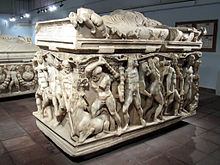


Excavations have shown that the region was inhabited during the Late Copper Age, around 3000 BC.
The Phrygians established their kingdom in central Anatolia in the eighth century BC and Xenophon describes Iconium (as the city was originally called) as the last city of Phrygia. The region was overwhelmed by Cimmerian invaders c. 690 BC. Later it formed part of the Persian Empire, until Darius III was defeated by Alexander the Great in 333 BC. Alexander's empire broke up shortly after his death and the town came under the rule of Seleucus I Nicator.
During the Hellenistic period the town was ruled by the kings of Pergamon. As Attalus III, the last king of Pergamon, was about to die without an heir, he bequeathed his kingdom to the Roman Republic. Once incorporated into the Roman Empire, under emperor Claudius, the city's name was changed to Claudiconium. During the reign of emperor Hadrianus it was known as Colonia Aelia Hadriana.
Saint Paul and Iconium
Paul and Silas probably visited Konya during Paul's Second Missionary Journey in about AD 50, as well as near the beginning of his Third Missionary Journey several years later.
According to the apocryphal Acts of Paul and Thecla, Iconium was also the birthplace of Saint Thecla, who saved the city from attack by the Isaurians in 354.
Byzantine Era
Under the Byzantine Empire, the city became the seat of a bishop, and in c. 370 was raised to the status of a metropolitan see for Lycaonia, with Saint Amphilochius as the first metropolitan bishop. In the 7th century it became part of the Anatolic Theme and was, together with the nearby (Caballa) Kaballah Fortress (Turkish: Gevale Kalesi) (location) a frequent target of Arab attacks during the Arab–Byzantine wars in the eighth to tenth century, being captured by Arabs in 723–724. The rebellious general Andronikos Doukas used the Kaballah fortress as his base in 905–906. During the tenth or eleventh century the church of Saint Amphilochius was constructed inside the citadel of Kaballa, housing the tomb of the saint which the Turks later believed to be the tomb of Plato, renaming the church to Eflâtun Mescidi (mosque of Plato). The monastery of Saint Chariton, another local from Iconium, was located a few miles away in Sylata.
The Seljuk Turks first raided the area in 1069, but a period of chaos overwhelmed Anatolia after the Seljuk victory in the Battle of Manzikert in 1071, and the Norman mercenary leader Roussel de Bailleul rose in revolt at Iconium. The city was finally conquered by the Seljuks in 1084.
Seljuk and Karamanid eras
Main articles: Anatolian Seljuk Sultanate and Karamanids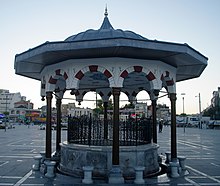
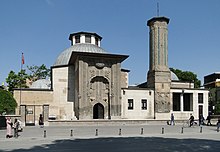
Iconium became the second capital of the Seljuk Sultanate of Rum after the fall of Nicaea until 1243. It was briefly occupied by the army of the First Crusade (August 1097) and Frederick Barbarossa (May 18, 1190) after the Battle of Iconium (1190). The area was reoccupied by the Turks after the Crusaders left.

Konya reached the height of its wealth and influence in the second half of the 12th century when the Seljuk sultans of Rum also subdued the Anatolian beyliks to their east, especially that of the Danishmends, thus establishing their rule over virtually all of eastern Anatolia,. They also acquired several port towns along the Mediterranean (including Alanya) and the Black Sea (including Sinop) and even gained a brief foothold in Sudak, Crimea. This golden age lasted until the first decades of the 13th century.
Many Persians and Persianised Turks from Persia and Central Asia migrated to Anatolian cities either to flee the invading Mongols or to benefit from the opportunities for educated Muslims in a newly established kingdom.

Following the fall of the Anatolian Seljuk Sultanate in 1307, Konya became the capital of the Karamanids, a Turkish beylik, which lasted until 1322 when the city was captured by the neighbouring Beylik of Karamanoğlu. In 1420, the Beylik of Karamanoğlu fell to the Ottoman Empire and, in 1453, Konya was made the provincial capital of the Karaman Eyalet.
Ottoman Empire
Main articles: Ottoman Empire, Karaman Eyalet, and Vilayet of KonyaUnder Ottoman rule, Konya was administered by the Sultan's sons (Şehzade), starting with Şehzade Mustafa and Şehzade Cem (the sons of Sultan Mehmed II), and continuing with the future Sultan Selim II.
Between 1483 and 1864, Konya was the administrative capital of the Karaman Eyalet. During the reforming Tanzimat period, it became the seat of the larger Vilayet of Konya which replaced the Karaman Eyalet, as part of the new vilayet system introduced in 1864.
In 1832 Anatolia was invaded by Mehmed Ali Paşa of Kavala whose son, İbrahim Paşa, occupied Konya. Although he was driven out with the help of the European powers, Konya went into a decline after this, as described by the British traveller, William Hamilton, who visited in 1837 and found a scene 'of destruction and decay', as he recorded in his Researches in Asia Minor, Pontus and Armenia, published in 1842.
Konya's textile and mining industries flourished under the Ottomans.
Turkish Republic
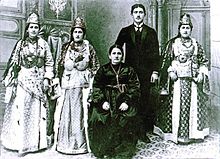
During the Turkish War of Independence (1919–1922) Konya was a major air base. In 1922, the air force, renamed as the Inspectorate of Air Forces, was headquartered in Konya. Before 1923, 4,000 Orthodox, Turkish-speaking and Greek-speaking Christians lived there. The Greek community numbered approximately 2,500 people who maintained, at their own expense, a church, a boys' school and a girls' school. In 1923 during the population exchange between Greece and Turkey, the Greeks of the nearby village of Sille were forced to leave as refugees and resettle in Greece.
Government
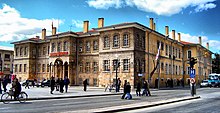
The first local administration in Konya was founded in 1830 and converted into a municipality in 1876. In March 1989, the municipality became a Metropolitan Municipality. As of that date, Konya had three central district municipalities (Meram, Selçuklu, Karatay) and a Metropolitan Municipality.
Economy
Home to several industrial parks. The city ranks among the Anatolian Tigers. In 2012 exports from Konya reached 130 countries. A number of Turkish industrial conglomerates, such as Bera (ex Kombassan) Holding, have their headquarters in Konya.
While agriculture-based industries play a role, the city's economy has evolved into a center for the manufacturing of components for the automotive industry; machinery manufacturing; agricultural tools; casting; plastic paints and chemicals; construction materials; paper and packaging; processed foods; textiles; and leather.
Turkey's largest solar farm is located 20 miles east of the city, near Karapınar.
Geography
Konya sits in the center of the largest province, in the largest plain (Konya Plain), and is the seventh most heavily populated city in Turkey.
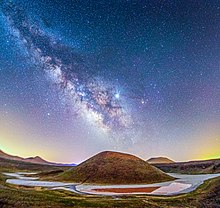
The city is in the southern part of the Central Anatolia Region with the southernmost side of the province hemmed in by the Taurus Mountains.
Climate
Konya has a cold semi-arid climate (BSk) under the Köppen classification and a temperate continental (Dc) climate under the Trewartha classification.
Summer daytime temperatures average 30 °C (86 °F), although summer nights are cool. The highest temperature recorded in Konya was 40.9 °C (106 °F) on 14 August 2023, closely beating the former record of 40.6 °C (105 °F) on 30 July 2000. Winters average −4.2 °C (24 °F), and the lowest temperature recorded was −26.5 °C (−16 °F) on 6 February 1972. Precipitation levels are low and happen mainly in winter and spring.
| Climate data for Konya (1991–2020, extremes 1929–2023) | |||||||||||||
|---|---|---|---|---|---|---|---|---|---|---|---|---|---|
| Month | Jan | Feb | Mar | Apr | May | Jun | Jul | Aug | Sep | Oct | Nov | Dec | Year |
| Record high °C (°F) | 19.3 (66.7) |
23.8 (74.8) |
28.9 (84.0) |
34.6 (94.3) |
34.4 (93.9) |
36.7 (98.1) |
40.6 (105.1) |
40.9 (105.6) |
38.8 (101.8) |
32.3 (90.1) |
25.4 (77.7) |
21.8 (71.2) |
40.9 (105.6) |
| Mean daily maximum °C (°F) | 4.6 (40.3) |
6.9 (44.4) |
12.5 (54.5) |
17.6 (63.7) |
22.8 (73.0) |
27.4 (81.3) |
31.0 (87.8) |
30.9 (87.6) |
26.7 (80.1) |
20.4 (68.7) |
12.7 (54.9) |
6.3 (43.3) |
18.3 (64.9) |
| Daily mean °C (°F) | −0.3 (31.5) |
1.3 (34.3) |
6.0 (42.8) |
10.9 (51.6) |
15.9 (60.6) |
20.5 (68.9) |
24.1 (75.4) |
24.0 (75.2) |
19.4 (66.9) |
13.4 (56.1) |
6.2 (43.2) |
1.5 (34.7) |
11.9 (53.4) |
| Mean daily minimum °C (°F) | −3.9 (25.0) |
−3.3 (26.1) |
0.2 (32.4) |
4.4 (39.9) |
9.0 (48.2) |
13.6 (56.5) |
17.1 (62.8) |
17.2 (63.0) |
12.3 (54.1) |
7.0 (44.6) |
0.8 (33.4) |
−2.2 (28.0) |
6.0 (42.8) |
| Record low °C (°F) | −28.2 (−18.8) |
−26.5 (−15.7) |
−16.4 (2.5) |
−8.6 (16.5) |
−1.2 (29.8) |
1.8 (35.2) |
6.0 (42.8) |
5.3 (41.5) |
−3.0 (26.6) |
−8.4 (16.9) |
−20.0 (−4.0) |
−26.0 (−14.8) |
−28.2 (−18.8) |
| Average precipitation mm (inches) | 35.9 (1.41) |
23.1 (0.91) |
27.4 (1.08) |
34.2 (1.35) |
38.2 (1.50) |
27.8 (1.09) |
6.5 (0.26) |
6.5 (0.26) |
15.9 (0.63) |
29.7 (1.17) |
34.5 (1.36) |
45.6 (1.80) |
325.3 (12.81) |
| Average precipitation days | 10.53 | 8.97 | 9.80 | 10.83 | 12.47 | 8.10 | 3.00 | 2.63 | 4.40 | 7.27 | 7.13 | 10.10 | 95.2 |
| Average relative humidity (%) | 79.8 | 73.3 | 63.4 | 58.7 | 56.1 | 47.5 | 38.9 | 39.4 | 44.2 | 57.6 | 70.1 | 79.9 | 59.0 |
| Mean monthly sunshine hours | 105.4 | 138.4 | 195.3 | 216.0 | 269.7 | 309.0 | 344.1 | 334.8 | 291.0 | 235.6 | 159.0 | 102.3 | 2,700.6 |
| Mean daily sunshine hours | 3.4 | 4.9 | 6.3 | 7.2 | 8.7 | 10.3 | 11.1 | 10.8 | 9.7 | 7.6 | 5.3 | 3.3 | 7.4 |
| Source 1: Turkish State Meteorological Service | |||||||||||||
| Source 2: NOAA (humidity) | |||||||||||||
Culture

Konya has a reputation for being one of the more religiously conservative metropolitan centres in Turkey.
Konya was the final home of Rumi (Mevlana), whose turquoise-domed tomb in the city is its primary tourist attraction. In 1273, Rumi's followers established the Mevlevi Sufi order of Islam and became known as the Whirling Dervishes.
Every Saturday, there are Whirling Dervish performances (semas) at the Mevlana Cultural Centre. Unlike some of the commercial performances staged in cities like Istanbul, these are genuinely spiritual sessions.
Expensive, richly patterned Konya carpets were exported to Europe during the Renaissance and were draped over furniture to show off the wealth and status of their owners. They often crop up in contemporary oil paintings as symbols of the wealth of the painter's clients.
Attractions
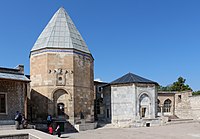
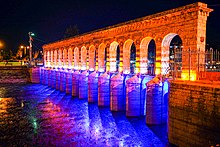
- Mevlâna Museum
- Alaaddin Mosque
- Ince Minaret Medrese—Museum
- Karatay Medrese—Museum
- Sırçalı Medrese
- Sahib-i Ata Mosque complex
- Konya Archaeological and Ethnography Museum
- Koyunoğlu Museum
- Atatürk House Museum
- Mevlana Cultural Centre
- Mevlana Festival
- Selimiye Mosque
- Aziziye Mosque
- Konya Science Centre (Turkish: Konya Bilim Merkezi)
- Konya Tropical Butterfly Garden
- Meram, suburb with popular waterside picnicking facilities
- Sille, 8 kilometres (5.0 miles) northwest from Mevlana Museum: antique village, mosques, churches, cave churches and catacombs
- Çatalhöyük
Food
One of the city's best-known dishes, etli ekmek consists of slices of lamb served on flaps of soft white bread. Konya is also known for unfeasibly long pides (Turkish pizzas) intended to be shared, and tirit, a traditional rice dish made from meat and assorted vegetables.

Konya is also known for its sweets, including cezerye, an old Turkish sweet made from carrots, and pişmaniye, which is similar to American cotton candy.
Sports
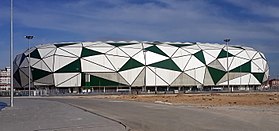
The city's football team Konyaspor is part of the Turkish Professional Football League. On May 31, 2017, they won their first national trophy, beating İstanbul Başakşehir to the Türkiye Kupası in a penalty shootout. They repeated this success on August 6, 2017, defeating Beşiktaş to win the Türkiye Süper Kupası (Turkish Super Bowl).
Konya Metropolitan Stadium (Konya Büyükşehir Stadyumu) is in the Selçuklu neighbourhood and can seat up to 42,000 spectators.
The city hosted the 2022 Islamic Solidarity Games in August 2022.
Education
Founded in 1975, Selçuk University had the largest number of students (76,080) of any public university in Turkey during the 2008–09 academic year. The other public university, Necmettin Erbakan University, was established in Konya in 2010.

Private colleges in Konya include the KTO Karatay University.
Konya hosts the Anatolian Eagle Tactical Training Centre for training NATO Allies and friendly Air Forces.
Transportation
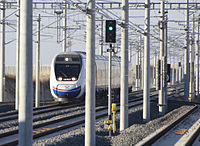

Intercity buses
The central bus station has connections to a range of destinations, including Istanbul, Ankara and İzmir. It is connected to the town centre by a tram.
Inner-city public transport
The Konya Tram network is 41 km (25 mi) long and has two lines with 41 stations. Opened in 1992, it was expanded in 1996 and 2015. The Konya Tram uses Škoda 28 T vehicles.
Work began on building a Konya Metro in 2020 and is expected to be completed in 2024 and will have 22 stations.
Konya also has an extensive inner-city bus network.
Railway
Konya is connected to Ankara, Eskişehir, Istanbul and Karaman via the high-speed railway services of the Turkish State Railways.
Airport and airbase
Konya Airport (KYA) is a public airport but also a military airbase used by NATO. The Third Air Wing of the 1st Air Force Command is based at the Konya Air Base. The wing controls the four Boeing 737 AEW&C Peace Eagle aircraft of the Turkish Air Force.
Notable people
- Jalal al-Din Muhammad Rumi, also called Mawlana or Mevlana, the inspiration behind the Sufi Mevlevi order (known for the Whirling Dervishes and Masnavi). He died and was buried in Konya in 1273.
- Amphilochius of Iconium, fourth century Christian bishop.
- Prokopios Lazaridis, Greek Orthodox metropolitan bishop of the Metropolis of Iconium
- Murat Yıldırım (actor), actor and presenter
- Hilmi Şenalp (1957-), architect.
Twin towns – sister cities
See also: List of twin towns and sister cities in TurkeyKonya is twinned with:
 Bârlad, Romania
Bârlad, Romania Ganja, Azerbaijan
Ganja, Azerbaijan Nishapur, Iran
Nishapur, Iran Al Qadarif, Sudan
Al Qadarif, Sudan Berlin, Germany
Berlin, Germany Sheki, Azerbaijan
Sheki, Azerbaijan Sylhet, Bangladesh
Sylhet, Bangladesh Multan, Pakistan
Multan, Pakistan Kyoto, Japan
Kyoto, Japan Tetovo, North Macedonia
Tetovo, North Macedonia Xi'an, China
Xi'an, China Ráckeve, Hungary
Ráckeve, Hungary Kirkuk, Iraq
Kirkuk, Iraq
See also
- Mevlâna Museum
- Anatolian Tigers
- Konya Carpets and Rugs
- Theodosius the Cenobiarch (c. 423–529 AD), monk, abbot, and saint born in Iconium; a founder and organiser of the cenobitic way of monastic life
- Thecla or Tecla, first-century virgin saint of the early Christian Church, born in Iconium
Notes
- Turkish pronunciation: [ˈkoɲ.ja]
- Turkic:Kuva-yı Havaiye Müfettişliği
- "İhtisab Agalıgi" (Islamic-Ottoman office for public regularity)
- Ana Jet Üssü or AJÜ
- Hava Kuvvet Komutanlığı
References
- "Turkey: Administrative Division (Provinces and Districts) - Population Statistics, Charts and Map".
- City Mayor: Ugur Ibrahim Altay(AKP) Elected in 2024 "Statistics by Theme > National Accounts > Regional Accounts". www.turkstat.gov.tr. Retrieved 11 May 2023.
- Forlanini, Massimo (2017). "South Central: The Lower Land and Tarḫuntašša". In Weeden, Mark; Ullmann, Lee (eds.). Hittite Landscape and Geography. Brill. p. 244. doi:10.1163/9789004349391_022. ISBN 978-90-04-34939-1.
- Bryce, Trevor (2006). The Trojans and their neighbours. London: Routledge. p. 81. ISBN 9780415349550.
- Klein, Jared; Joseph, Brian; Fritz, Matthias (2017). Handbook of Comparative and Historical Indo-European Linguistics. de Gruyter. p. 239. ISBN 978-3-11-026128-8.
- Bryce, Trevor (2006). The Trojans and their neighbours. London: Routledge. p. 81. ISBN 9780415349550.
- Klein, Jared; Joseph, Brian; Fritz, Matthias (2017). Handbook of Comparative and Historical Indo-European Linguistics. de Gruyter. p. 239. ISBN 978-3-11-026128-8.
- ^ "Konya". Encyclopædia Britannica. Retrieved 25 May 2015.
- "KONYA İç Anadolu bölgesinde şehir ve bu şehrin merkez olduğu il". TDV Encyclopedia of Islam (44+2 vols.) (in Turkish). Istanbul: Turkiye Diyanet Foundation, Centre for Islamic Studies. 1988–2016.
- Ramsay, William Mitchell (1908). The Cities of St. Paul. A.C. Armstrong. pp. 315–384.
- Bruce, Frederick Fyvie (1977). Paul: Apostle of the Heart Set Free. Eerdmans. p. 475. ISBN 978-0-8028-3501-7.
- Bruce, Frederick Fyvie (1977). Paul: Apostle of the Heart Set Free. Eerdmans. p. 286. ISBN 978-0-8028-3501-7.
- ^ Foss, Clive (1991). "Ikonion". In Kazhdan, Alexander (ed.). Oxford Dictionary of Byzantium. London and New York: Oxford University Press. p. 985. ISBN 978-0-19-504652-6.
- Whittow, Mark (1996). The Making of Byzantium, 600-1025. University of California Press. p. 138. ISBN 9780520204966. Retrieved 6 October 2023.
- Heald Jenkins, Romilly James (1987). Byzantium The Imperial Centuries, AD 610–1071. University of Toronto Press. p. 204. ISBN 9780802066671. Retrieved 6 October 2023.
- Tekinalp, V. Macit (2009). "Palace churches of the Anatolian Seljuks: tolerance or necessity?". Byzantine and Modern Greek Studies. 332 (2): 148–167. doi:10.1179/174962509X417645.
- Breytenbach, Cilliers; Zimmermann, Christiane (2017). Early Christianity in Lycaonia and Adjacent Areas From Paul to Amphilochius of Iconium. Brill. ISBN 9789004352520.
- Hiro, Dilip (2011). Inside Central Asia. Gerald Duckworth & Company. p. 76. ISBN 978-0-7156-4038-8.
- Mango, Andrew (1972). Discovering Turkey. Hastings House. p. 61. ISBN 0-8038-7111-2. OCLC 309327.
- Freely, John (1998). The Western Interior of Turkey (1st ed.). Istanbul: SEV. pp. 235–36. ISBN 9758176226.
- Chen, Yuan Julian (2021-10-11). "Between the Islamic and Chinese Universal Empires: The Ottoman Empire, Ming Dynasty, and Global Age of Explorations". Journal of Early Modern History. 25 (5): 422–456. doi:10.1163/15700658-bja10030. ISSN 1385-3783. S2CID 244587800.
- "Bir Hata Oluştu". Hvkk.tsk.tr. Archived from the original on 5 May 2015. Retrieved 25 May 2015.
- Kocatürk, Utkan (1983). Atatürk ve Türkiye Cumhuriyeti tarihi kronolojisi, 1918–1938 (in Turkish). Türk Tarih Kurumu Basımevi. p. 634.
- "IFMSA Exchange Portal". Exchange.ifmsa.org. Retrieved 7 August 2018.
- "Financial Times: Reports — Anatolian tigers: Regions prove plentiful". Ft.com. Archived from the original on 2022-12-10. Retrieved 7 August 2018.
- root. "Anatolian Tigers". Investopedia. Retrieved 25 May 2015.
- "Zaman: Anatolian tigers conquering the world". Archived from the original on 2013-08-21. Retrieved 2013-08-21.
- ^ "General Overview Of The Konya Economy". En.kto.org.tr. Retrieved 25 May 2015.
- "Anasayfa | Bera Holding". beraholding.com.tr. Retrieved 2022-07-21.
- "The World's Largest Solar Power Plant in Konya". TR Dergisi. 2017-05-15. Retrieved 2022-07-21.
- "Turkey: Provinces & Major Cities – Statistics & Maps on City Population". Archived from the original on 2017-01-14. Retrieved 2013-12-31.
- "Updated world map of the Köppen-Geiger climate classification" (PDF). Hydrology and Earth System Sciences Discussions. Retrieved 7 August 2018.
- "Resmi İstatistikler: İllerimize Ait Mevism Normalleri (1991–2020)" (in Turkish). Turkish State Meteorological Service. Retrieved 6 July 2021.
- "World Meteorological Organization Climate Normals for 1991–2020: Konya" (CSV). National Centers for Environmental Information. Retrieved 2 August 2023.
- "'Islam problem' baffles Turkey". BBC News. 2004-12-03. Retrieved 2019-08-29.
- Campbell, Gordon (2006). "Carpet II: History". The Grove Encyclopedia of Decorative Arts. Vol. 1. Oxford University Press. p. 189. ISBN 978-0-19-518948-3.
- "Carpets of the Ottoman Period". Old Turkish Carpets. 2019-06-19. Retrieved 2019-08-29.
- ^ "Konya Museums and Ruins". www.ktb.gov.tr.
- McLean, B. Hudson (2018). Greek and Latin Inscriptions in the Konya Archaeological Museum. British Institute of Archaeology at Ankara. ISBN 978-1-898249-14-6. Retrieved 7 August 2018 – via Google Books.
- "Mevlâna Culture Centre | Konya, Turkey | Entertainment - Lonely Planet".
- "Konya Büyükşehir Belediyesi". Konya.bel.tr (in Turkish). Archived from the original on 2018-08-08. Retrieved 2019-08-29.
- "Small Ruminant Congress". kucukbas2014.com. 2014-10-18. Archived from the original on 2014-10-18. Retrieved 2019-08-29.
- "Konya Necmettin Erbakan Üniversitesi". Archived from the original on 27 April 2015. Retrieved 25 May 2015.
- "KTO Karatay Üniversitesi". Karatay.edu.tr. Retrieved 2011-09-16.
- Official Web Site
- "Škoda Transportation wins Konya tram contract". Railway Gazette. 2013-03-04. Retrieved 2019-08-29.
- Uysal, Onur (2020-10-01). "Last status of metro and tram projects of Turkey". Rail Turkey En. Retrieved 2022-07-22.
- "Opening of Ankara – Konya fast line completes strategic link". Railway Gazette. 24 August 2011. Retrieved 2013-02-12.
- "Invensys commissions ERTMS solution on Turkish High Speed Line". European Railway Review. 7 September 2011. Archived from the original on 6 January 2012. Retrieved 20 December 2011.
- Mehmet Kayhan YILDIZ- Hasan BÖLÜKBAŞ- Serdar ÖZGÜR- Tolga YANIK- Hasan DÖNMEZ/ KONYA,(DHA) (21 February 2014). "TSK yeni yıldızı Barış Kartalı'na kavuştu". HÜRRİYET – TÜRKİYE'NİN AÇILIŞ SAYFASI. Retrieved 25 May 2015.
- "Turkey takes delivery of military aircraft". TodaysZaman. Archived from the original on February 22, 2015. Retrieved 25 May 2015.
- Battutah, Ibn (2002). The Travels of Ibn Battutah. London: Picador. pp. 106, 309. ISBN 978-0-330-41879-9.
- Thonemann, Peter (2011-05-04). "Amphilochius of Iconium and Lycaonian Asceticism". Journal of Roman Studies. 101: 185–205. doi:10.1017/s0075435811000037. ISSN 0075-4358. S2CID 162127197.
- Savramis, Demosthenes (1968). Die soziale Stellung des Priesters in Griechenland [Social position of the priest in Greece] (in German). E. J. Brill.
- Kiminas, Demetrius (2009). The ecumenical patriarchate : a history of its metropolitanates with annotated hierarch catalogs. San Bernardino, CA: Borgo Press. p. 100. ISBN 978-1-4344-5876-6.
- Rizvi, Kishwar (2015). The Transnational Mosque: Architecture and Historical Memory in the Contemporary Middle East. UNC Press Books. p. 56. ISBN 978-1-4696-2117-3. Retrieved 16 May 2020.
- "Rumi Remembered in Birthplace of Shams". Archived from the original on 7 April 2015. Retrieved 21 March 2015.
- Kyoto İle Kardeş Şehir Protokolü İmzalandı, Heyet Japon Parkı'nı Gezdi Archived 2014-10-16 at the Wayback Machine, Konya Büyükşehir Belediyesi (2010)
- "Turkish FM's speech to Kirkuk's Turkmen community". ekurd.net. Retrieved 13 May 2024.
- "UNPO: Iraqi Turkmen: Turkey Promises Protection Of Turkmen". unpo.org. 2 November 2009. Retrieved 13 May 2024.
General
- "About Konya/ Geography and Transportation". Konya Sanayi Odasi. Archived from the original on September 3, 2017. Retrieved November 12, 2016.
- Gould, Kevin (9 April 2010). "Konya, In a Whirl of its Own". The Guardian. Retrieved November 12, 2016.
- "7 Good Eats in Konya". My Traveling Joys. Retrieved November 12, 2016.
Further reading
Published in the 19th century
- "Konia". Handbook for Travellers in Turkey (3rd ed.). London: J. Murray. 1854. OCLC 2145740.
- Clément Huart (1897). Konia, la ville des derviches tourneurs (in French). Paris: Leroux. ISBN 9780524077849.
Published in the 20th century
- Hogarth, David George (1911). "Konia" . Encyclopædia Britannica. Vol. 15 (11th ed.). p. 893.
- E. Broadrup (1995). "Konya/Catal Huyuk". International Dictionary of Historic Places. Chicago: Fitzroy Dearborn.
Published in the 21st century
- C. Edmund Bosworth, ed. (2007). "Konya". Historic Cities of the Islamic World. Leiden: Koninklijke Brill.
- "Konya". Grove Encyclopedia of Islamic Art & Architecture. Oxford University Press. 2009.
External links
 Konya travel guide from Wikivoyage
Konya travel guide from Wikivoyage- Britannica.com: Konya
- More information about Konya Archived 2017-12-29 at the Wayback Machine
- Emporis: Database of highrises and other structures in Konya
- Detailed Pictures of Mevlana Museum
- Pictures of the city, including Mevlana Museum and several Seljuk buildings
- 600 Pictures of the city and sights
- Extensive collection of pictures of the Mevlana museum in Konya
- Ramsay, William Mitchell (1908). The Cities of St. Paul. A.C. Armstrong. pp. 315–384.
- Konya Hava Durumu
- Konya Hava Durumu 15 günlük
- ArchNet.org. "Konya". Cambridge, Massachusetts, USA: MIT School of Architecture and Planning. Archived from the original on 2012-10-23. Retrieved 2013-02-10.
- "Konya". Islamic Cultural Heritage Database. Istanbul: Organization of Islamic Cooperation, Research Centre for Islamic History, Art and Culture. Archived from the original on May 16, 2013.
| Konya in Konya Province of Turkey | ||
|---|---|---|
| Districts |  | |
| Metropolitan municipalities are bolded. | ||
| Metropolitan municipalities in Turkey | |
|---|---|
| Journeys of Paul the Apostle | |
|---|---|
| First journey | |
| Second journey | |
| Third journey | |
| Largest cities or towns in Turkey TÜİK's address-based calculation from 31 December 2023 published at 7th of February 2024. | |||||||||||||||||||||||||||||||||||||||||||||||||||||||||||||||||||||||
|---|---|---|---|---|---|---|---|---|---|---|---|---|---|---|---|---|---|---|---|---|---|---|---|---|---|---|---|---|---|---|---|---|---|---|---|---|---|---|---|---|---|---|---|---|---|---|---|---|---|---|---|---|---|---|---|---|---|---|---|---|---|---|---|---|---|---|---|---|---|---|---|
| |||||||||||||||||||||||||||||||||||||||||||||||||||||||||||||||||||||||




